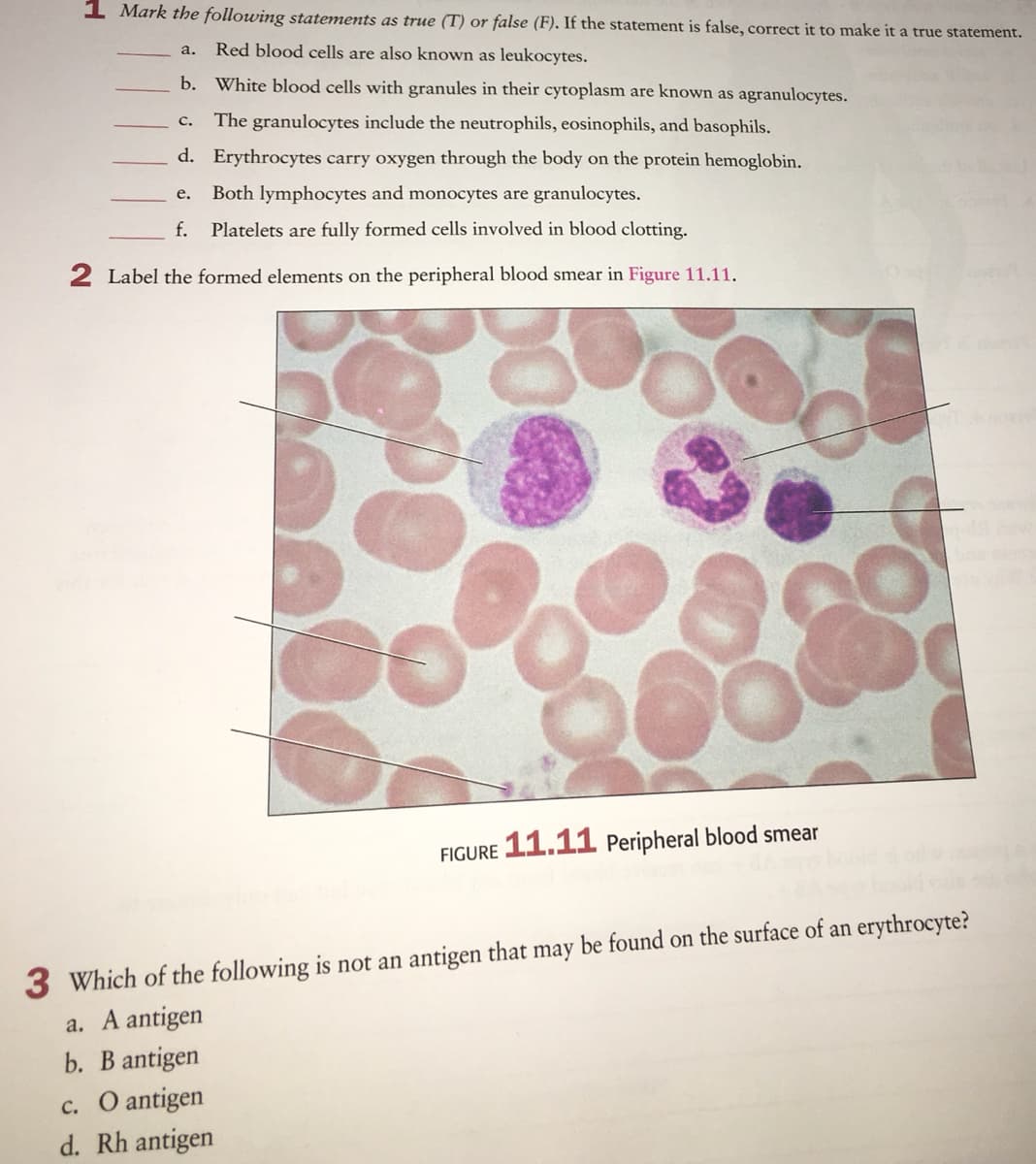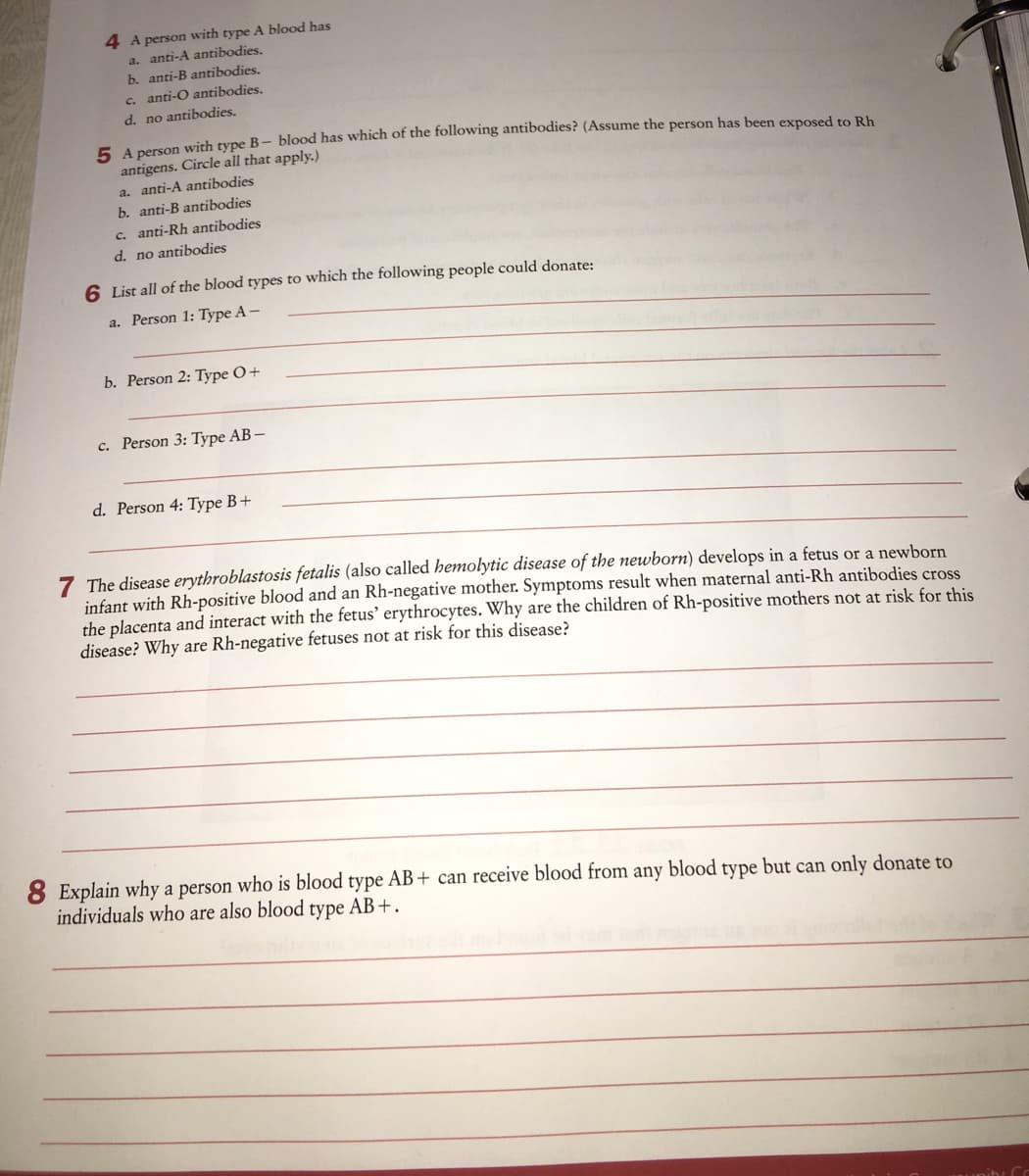the following statements as true (T) or false (F). If the statement is false, correct it to make it a true statement. a. Red blood cells are also known as leukocytes. b. White blood cells with granules in their cytoplasm are known as agranulocytes. The granulocytes include the neutrophils, eosinophils, and basophils. c. d. Erythrocytes carry oxygen through the body on the protein hemoglobin. е. Both lymphocytes and monocytes are granulocytes. f. Platelets are fully formed cells involved in blood clotting.
the following statements as true (T) or false (F). If the statement is false, correct it to make it a true statement. a. Red blood cells are also known as leukocytes. b. White blood cells with granules in their cytoplasm are known as agranulocytes. The granulocytes include the neutrophils, eosinophils, and basophils. c. d. Erythrocytes carry oxygen through the body on the protein hemoglobin. е. Both lymphocytes and monocytes are granulocytes. f. Platelets are fully formed cells involved in blood clotting.
Biology: The Dynamic Science (MindTap Course List)
4th Edition
ISBN:9781305389892
Author:Peter J. Russell, Paul E. Hertz, Beverly McMillan
Publisher:Peter J. Russell, Paul E. Hertz, Beverly McMillan
Chapter44: The Circulatory System
Section: Chapter Questions
Problem 3TYK
Related questions
Question

Transcribed Image Text:1 Mark the following statements as true (T) or false (F). If the statement is false, correct it to make it a true statement.
Red blood cells are also known as leukocytes.
a.
b. White blood cells with granules in their cytoplasm are known as agranulocytes.
The granulocytes include the neutrophils, eosinophils, and basophils.
с.
d. Erythrocytes carry oxygen through the body on the protein hemoglobin.
е.
Both lymphocytes and monocytes are granulocytes.
f.
Platelets are fully formed cells involved in blood clotting.
2 Label the formed elements on the peripheral blood smear in Figure 11.11.
FIGURE 11.11 Peripheral blood smear
3 Which of the following is not an antigen that may be found on the surface of an erythrocyte?
a. A antigen
b. B antigen
c. O antigen
d. Rh antigen

Transcribed Image Text:4 A person with type A blood has
a. anti-A antibodies,
b. anti-B antibodies.
c. anti-O antibodies.
d. no antibodies.
E lomon wvirh type B- blood has which of the following antibodies? (Assume the person has been exposed to Rh
antigens. Circle all that apply.)
a. anti-A antibodies
b. anti-B antibodies
c. anti-Rh antibodies
d. no antibodies
6 List all of the blood types to which the following people could donate:
a. Person 1: Type A-
b. Person 2: Type O+
c. Person 3: Type AB –
d. Person 4: Type B+
7 The disease erythroblastosis fetalis (also called hemolytic disease of the newborn) develops in a fetus or a newborn
infant with Rh-positive blood and an Rh-negative mother. Symptoms result when maternal anti-Rh antibodies cross
the placenta and interact with the fetus' erythrocytes. Why are the children of Rh-positive mothers not at risk for this
disease? Why are Rh-negative fetuses not at risk for this disease?
8 Explain why a person who is blood type AB + can receive blood from any blood type but can only donate to
individuals who are also blood type AB+.
Expert Solution
This question has been solved!
Explore an expertly crafted, step-by-step solution for a thorough understanding of key concepts.
This is a popular solution!
Trending now
This is a popular solution!
Step by step
Solved in 3 steps

Knowledge Booster
Learn more about
Need a deep-dive on the concept behind this application? Look no further. Learn more about this topic, biology and related others by exploring similar questions and additional content below.Recommended textbooks for you

Biology: The Dynamic Science (MindTap Course List)
Biology
ISBN:
9781305389892
Author:
Peter J. Russell, Paul E. Hertz, Beverly McMillan
Publisher:
Cengage Learning

Anatomy & Physiology
Biology
ISBN:
9781938168130
Author:
Kelly A. Young, James A. Wise, Peter DeSaix, Dean H. Kruse, Brandon Poe, Eddie Johnson, Jody E. Johnson, Oksana Korol, J. Gordon Betts, Mark Womble
Publisher:
OpenStax College


Biology: The Dynamic Science (MindTap Course List)
Biology
ISBN:
9781305389892
Author:
Peter J. Russell, Paul E. Hertz, Beverly McMillan
Publisher:
Cengage Learning

Anatomy & Physiology
Biology
ISBN:
9781938168130
Author:
Kelly A. Young, James A. Wise, Peter DeSaix, Dean H. Kruse, Brandon Poe, Eddie Johnson, Jody E. Johnson, Oksana Korol, J. Gordon Betts, Mark Womble
Publisher:
OpenStax College



Comprehensive Medical Assisting: Administrative a…
Nursing
ISBN:
9781305964792
Author:
Wilburta Q. Lindh, Carol D. Tamparo, Barbara M. Dahl, Julie Morris, Cindy Correa
Publisher:
Cengage Learning

Cardiopulmonary Anatomy & Physiology
Biology
ISBN:
9781337794909
Author:
Des Jardins, Terry.
Publisher:
Cengage Learning,